Recently, The Immanent Frame has initiated a series of conversations around teaching, beginning with an “off the cuff” published last fall entitled “What are you teaching?”. Readers have often reported that they view TIF as a teaching tool, insofar as it has introduced them to new scholarship or served as a source of essays they assign to both undergraduates and graduate students. We are hoping to embrace and further cultivate the site’s function as a teaching resource.
In this “off the cuff” discussion, we focus particularly on digital resources and their relationship to pedagogy. We invited contributors to provide a brief response describing a digital project they created or use in the classroom. We asked them to describe the resource’s development, content, and form, and also to reflect on how it may advance specific pedagogical goals. Ultimately, our question was simple: How have you imagined this resource serving students and teachers?
This conversation builds on previous work of the SSRC’s Program on Religion and the Public Sphere as well as broader conversations on religion and digital scholarship.
The contributors are:
Melanie Adrian, Amélie Barras, and Jennifer Selby | “Producing Islam(s) in Canada” Student Podcasts
Emily Floyd | MAVCOR Digital Spaces Project and User Galleries
Chris Gratien | The Ottoman History Podcast
Elizabeth Shakman Hurd | Teaching Law and Religion Case Study Archive
Lincoln Mullen | America’s Public Bible
Alexander van der Haven | Teaching Law and Religion Case Study Archive
Isaac Weiner and Amy DeRogatis | American Religious Sounds Project
______
Melanie Adrian (Carleton University), Amélie Barras (York University), and Jennifer A. Selby (Memorial University of Newfoundland)
Many readers of The Immanent Frame will agree that media representations about Islam and Muslims are often misinformed or misguided. As academics who study Islam and Muslims in Canada, we know much of what is said is uneducated or blatantly Islamophobic.
To consider and counter this trend with a teaching tool, we invited three talented students from Carleton University’s School of Journalism and Communication in Ottawa to a SSHRC-funded workshop entitled “Producing Islam(s) in Canada.” It was organized around three case studies: the allowance of the niqab in Canadian citizenship ceremonies, religious accommodations at maple sugar shacks in Quebec, and the surveillance of Muslim Canadian men in an era of securitization.
The students had unimpeded access to our discussions and to the invited scholars. Following our meeting, we asked them to develop short podcasts that were conversant with the diversity of Islam and nuanced in their approach to the subject matter. Admittedly, we hoped to create different stories from those that are typically available.
We may be biased, but we think the results are impressive. Lauren Sproule, Salma Mahgoub, and Jordan Omstead each developed a 15-18 minute segment taking up one of the case studies. Their narrations draw on interdisciplinary research, keen political analysis, as well as the perspectives of experts on the issues.
The podcasts highlight the complexity of issues of Muslim representation in Canada. They also provide a window into broader debates around accommodation, minority/majority relations, masculinities, and the place of religion in the public sphere. To date, we have used the podcasts in courses in religion, political science, anthropology, and law. Issues we discuss come alive in a format students appreciate. Moreover, involving the journalism students in the podcasts’ production offered them a unique educational opportunity. We hope to replicate this collaborative model in future projects.
______
Emily Floyd (Editor and Curator, MAVCOR)
Since 2012, the website of the Center for the Study of Material and Visual Cultures of Religion (MAVCOR) has provided born-digital, double-blind peer-reviewed content on our subjects of inquiry. It is open access and free of pay walls, available for use by researchers, professors, students, religious communities, and the general interested public. The content includes an academic journal, MAVCOR Journal, and an exhibition space, the Material Objects Archive.
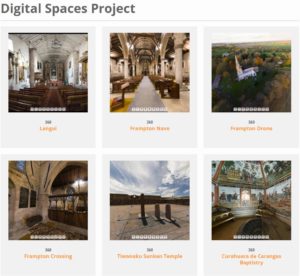 We recently launched two new tools particularly suited for the classroom. MAVCOR’s Digital Spaces Project provides 360-degree panoramas (“360s”), high-resolution gigapixel photographs (“Zooms”), and drone images of spaces that sizable audiences have understood to be religious. The first of these are already available online and offer instructors a new way of sharing these religious buildings and spaces with their students. In the future, we plan to collaborate with scholars to digitize additional locations and create open-access virtual reality tours of these spaces so viewers can have a more immersive experience than that typically offered by still photographs.
We recently launched two new tools particularly suited for the classroom. MAVCOR’s Digital Spaces Project provides 360-degree panoramas (“360s”), high-resolution gigapixel photographs (“Zooms”), and drone images of spaces that sizable audiences have understood to be religious. The first of these are already available online and offer instructors a new way of sharing these religious buildings and spaces with their students. In the future, we plan to collaborate with scholars to digitize additional locations and create open-access virtual reality tours of these spaces so viewers can have a more immersive experience than that typically offered by still photographs.
Earlier this month, we launched the User Galleries. Created in response to feedback from teachers interested in having a more direct way of engaging with the MAVCOR site, Galleries allows visitors to create user accounts and then compile groupings of articles, material objects, and Digital Spaces Project 360s and Zooms. Users may designate their galleries public or private and can include notes and commentary both on the gallery as a whole and on individual items included within the gallery. We envision Galleries as a tool for instructors—perhaps assigning students to create galleries for class or creating galleries that students may then read and view—as well as for researchers and the general public.
______
Chris Gratien (University of Virginia)
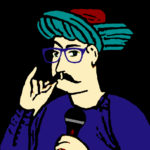 The Ottoman History Podcast (OHP) features conversations about the Ottoman Empire, the modern Middle East, and the Islamicate world. Since 2011, more than three hundred scholars and students have appeared on the program. By bringing together hundreds of voices from the field, the program presents a picture of the Ottoman Empire that reflects the breadth of current scholarly inquiry as well as the diversity of many ethno-religious communities who have cohabited the region for centuries.
The Ottoman History Podcast (OHP) features conversations about the Ottoman Empire, the modern Middle East, and the Islamicate world. Since 2011, more than three hundred scholars and students have appeared on the program. By bringing together hundreds of voices from the field, the program presents a picture of the Ottoman Empire that reflects the breadth of current scholarly inquiry as well as the diversity of many ethno-religious communities who have cohabited the region for centuries.
Founded by Emrah Safa Gurkan and myself when we were graduate students, the project has served as a pedagogical tool for more than a dozen other graduate students who have trained extensively in various facets of interviewing, audio production, and web publication through their involvement. OHP has also become an integral component of university syllabi. Many instructors use the interviews as complements to weekly readings and even make the podcast medium itself, and our program in particular, the centerpiece of a class that pushes students to think about history as a conversation happening across various media. Although we never anticipated this use, it is an example of how our activities serve the larger mission of making discussion of history more accessible and more public.
We operate on the assumption that nuanced academic discussion should not be confined to the walls of the university; it should take place in the venues where other intellectual debate occurs. Internet users should see content related to the study of the past on social media and in the same places where other types of information are exchanged and discussed. If scholarship is being produced in the United States about another part of the world—in our case, Turkey—listeners in that part of the world should be able to access that scholarship and be part of the conversation. Not everything can be said in a podcast; we should not overstate the importance of the medium vis a vis other forms of publication. But the podcast can be more than a place for scholars to pursue self-promotion. Through this project, we are not only reaching out to a broader audience but also sending the message to students that the debates and conversations we have do not stop at the classroom door.
______
Elizabeth Shakman Hurd (Northwestern University)
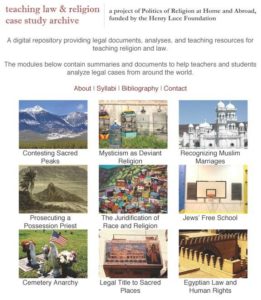 I am developing a new undergraduate seminar based on a new open access teaching resource, the Teaching Law and Religion Case Study Archive, created by Winnifred Sullivan and myself and developed under the auspices of two collaborative projects supported by the Henry Luce Foundation: Politics of Religious Freedom: Contested Norms and Local Practices and Politics of Religion at Home and Abroad. Launched in fall 2017, the archive presents resources and analysis of legal cases and background materials from different parts of the world. Featuring different legal, political, and religious institutions and histories, the cases provide a series of templates for thinking creatively and comparatively about the intersections of law, religion, culture, and politics. The new course will connect the site’s resources with local (Northwestern, Evanston, and Chicago) communities and concerns, particularly in intersections of religion, race, and indigeneity.
I am developing a new undergraduate seminar based on a new open access teaching resource, the Teaching Law and Religion Case Study Archive, created by Winnifred Sullivan and myself and developed under the auspices of two collaborative projects supported by the Henry Luce Foundation: Politics of Religious Freedom: Contested Norms and Local Practices and Politics of Religion at Home and Abroad. Launched in fall 2017, the archive presents resources and analysis of legal cases and background materials from different parts of the world. Featuring different legal, political, and religious institutions and histories, the cases provide a series of templates for thinking creatively and comparatively about the intersections of law, religion, culture, and politics. The new course will connect the site’s resources with local (Northwestern, Evanston, and Chicago) communities and concerns, particularly in intersections of religion, race, and indigeneity.
One example is the 2009 “Jews’ Free School” (JFS) case, which arose in a non-US jurisdiction but carries important implications for learning about the practice of Judaism in the United Kingdom and the United States contexts, as well as our respective legal and educational systems. The case is a bit of a whirlwind but this makes it fun to teach. It involved a dispute over the preferential admissions process at a popular Jewish school in London. The judges attempted to answer three interrelated questions: (1) who is a Jew; (2) who gets to decide; and (3) does the orthodox Jewish practice of determining Jewish status by matrilineal descent violate the Race Relations Act of 1976? The court instructed JFS to establish a new test that did not make determinations of Jewish identity based on ethnicity but rather based on practice and belief.
The JFS case generates lively discussion and, inevitably, leads to more questions. What would happen to an American student in similar circumstances? Are similar circumstances even possible given disestablishment in the United States and establishment in the United Kingdom, different traditions of Judaism, and different educational systems? How do you “prove” that you are a Jew according to the new JFS admissions regimen, and is that a reasonable demand to place on students and their families? The course explores all of these questions, and will also look into Chicago Jewish schools’ admissions policies to bring the case closer to home.
______
Lincoln Mullen (George Mason University)
America’s Public Bible is a website that explores how Americans in the nineteenth and early twentieth centuries quoted the Bible in newspapers. The centerpiece of the current site is an interactive visualization where the user enters a verse from the Bible or chooses from several that have been preselected. A visualization then shows a time series of how frequently the verse was quoted over time, while a table lists specific quotations of that verse in newspapers. A user can follow links to the images of the newspaper article.
A much expanded version of the site with several chapters worth of interpretative essays will be published as a digital monograph by Stanford University Press. But the prototype is still suitable for using in the classroom.
One assignment would be to have students examine the ways a single verse was used over time through periodization, contextualization, and close reading. For example, take the following verse: “I have shewed you all things, how that so labouring ye ought to support the weak, and to remember the words of the Lord Jesus, how he said, It is more blessed to give than to receive” (Acts 20:35).
Periodization: The time series clearly shows that the verse became more popular over time. But what was the reason for this increasing popularity? And was the phrase “labouring ye ought to support the weak” or the phrase “it is more blessed to give than to receive” more likely to be quoted?
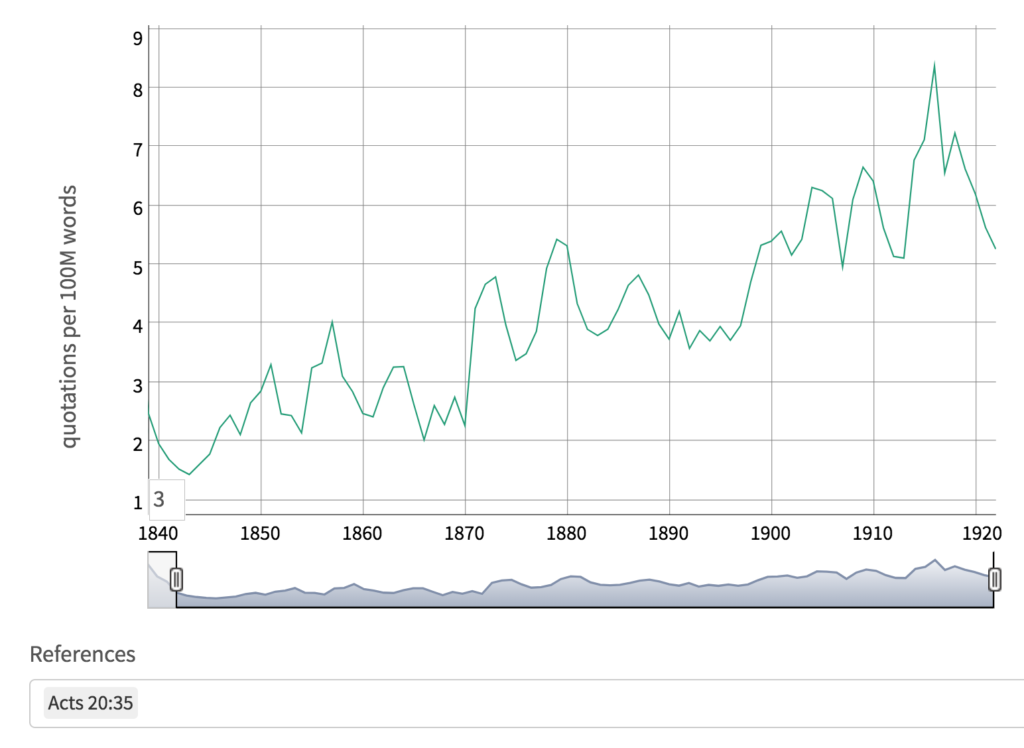
Context: Students can then look up the quotations of those verses in the newspapers. This requires them to see the quotation in the context of the newspaper page, as well as to set it in the chronological context of the verse’s relative popularity to other verses.
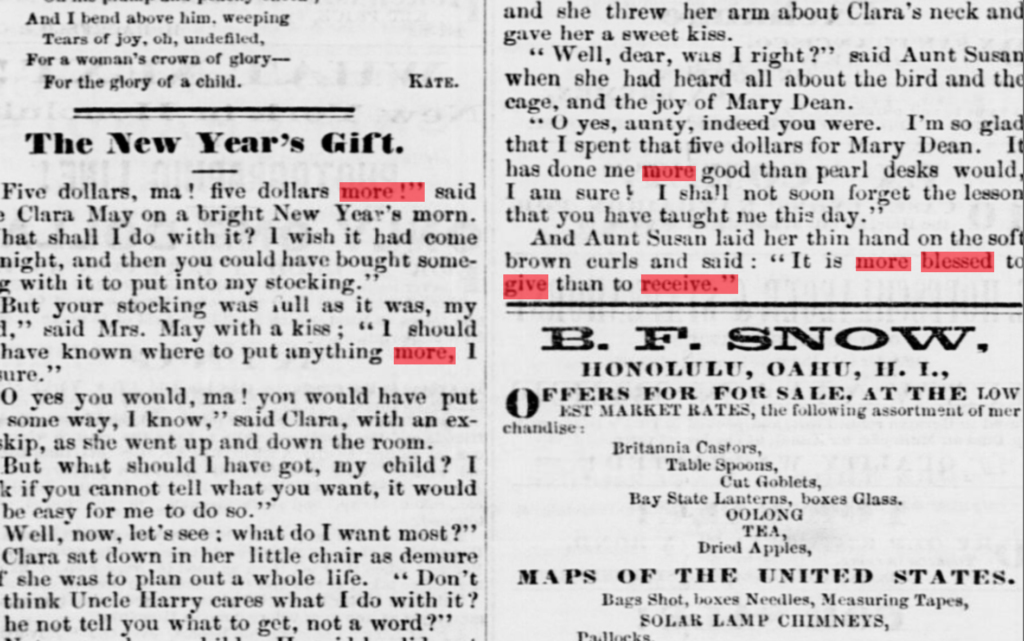
Close reading: Students can then read some selection of articles that quote the verse. They can unpack the various ways the text was used to understand how Bible served as a touchstone for many people who nevertheless interpreted it in rather different ways. In this case, they would find that much of the verse’s increasing popularity was due to its use in Christmas advertisements.
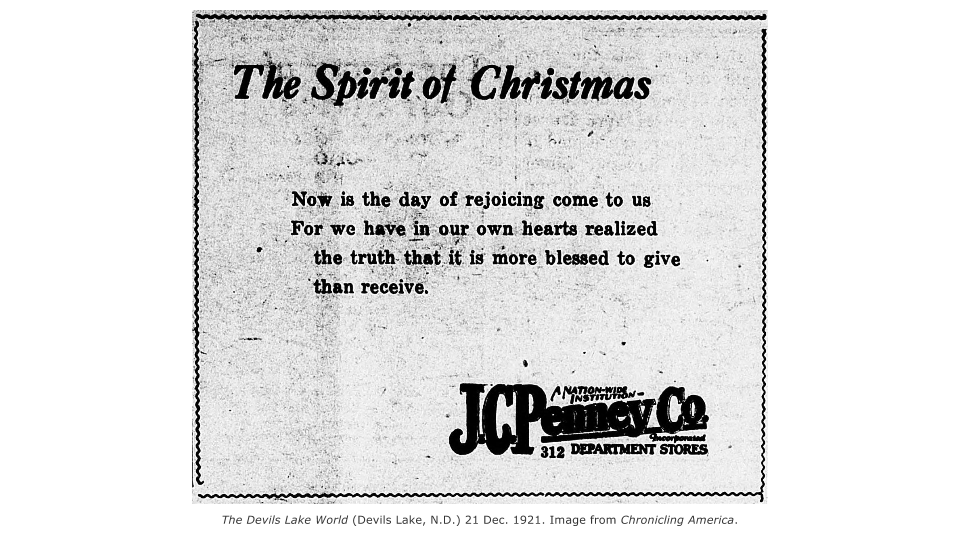
Such an assignment might be best paired with readings such as Leigh Eric Schmidt’s Consumer Rites, to understand the relationship between holidays and consumer capitalism in the case of Acts 20:35. Or if one were to look at the verse God has “made of one blood all nations of men” (Acts 17:26), the reading might be the chapter on “The Crisis over the Bible” in Mark Noll’s The Civil War as a Theological Crisis. This assignment would usefully point out to students how the Bible spoke (or was made to speak) many issues in American public life, from war and capitalism to race and gender. The Bible served as a common yet contested text, and students can use the site to trace the lines of those debates for themselves.
______
Alexander van der Haven (Ben-Gurion University of the Negev)
Vetted on three continents, one of my courses that always attracts many students is Religion in the 21st Century. Its title draws not only students attracted to religious history but also lures students who are not interested in anything beyond the present and the immediate future. However, once firmly enrolled, they are served texts from the last four hundred years.
Over the years, I have tried to make up for this deception by gradually substituting the assigned readings with material more oriented to the present-minded soul. When addressing the issue of religion and the state I initially assigned the French Jewish Sanhedrin’s pledge to Napoleon not to challenge the secular laws. I still use this in the course, but I replaced the reading with a chapter of Winnifred Sullivan’s The Impossibility of Religious Freedom, which describes the fascinating Warner v. City of Boca Raton case (decided 2001). Warner v. City of Boca Raton pitted bereaved family members who placed ornaments on the graves of their beloved ones against the municipality’s regulation of such ornaments.
The present incarnation of the assignment for the religion and state section sticks to the Boca Raton case but, rather than reading a linear prose discourse, the students explore the Cemetery Anarchy section of the digital Teaching Law and Religion Case Study Archive. Cemetery Anarchy presents a brief synopsis of the case and further allows the user to explore the case by offering links to, among others, court documents, a short lecture about the case by Sullivan, and several articles offering a wider context to the case. This assignment gives students the agency, and therefore responsibility, to explore a source by themselves. Rather than being assigned a specific text, I assign them a question which they need to answer with the help of this repository. This assignment also prevents Googling instead of reading, and I can trust that the territory, explored through clicks and scrolling, consists of high-quality texts.
______
Isaac Weiner (Ohio State University) and Amy DeRogatis (Michigan State University)
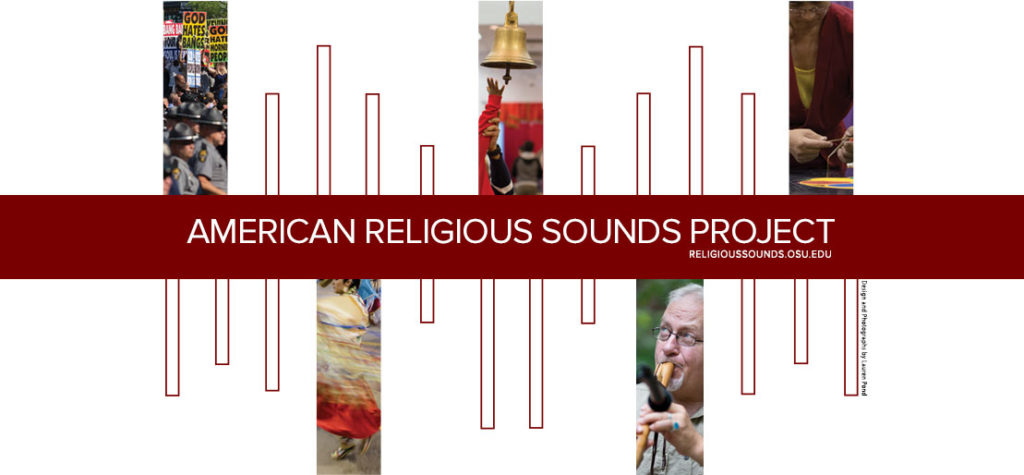 The American Religious Sounds Project (ARSP), a collaborative initiative of Michigan State and Ohio State Universities, supported by a generous grant from the Henry Luce Foundation, offers new resources for documenting and interpreting the diversity of American religious life by attending to its varied sonic cultures. The ARSP centers on: (1) the construction of a unique sonic archive, documenting the diversity of everyday religious life through newly produced field recordings, interviews, and oral histories; and (2) the development of a digital platform for organizing and presenting these materials, which will launch in May 2018.
The American Religious Sounds Project (ARSP), a collaborative initiative of Michigan State and Ohio State Universities, supported by a generous grant from the Henry Luce Foundation, offers new resources for documenting and interpreting the diversity of American religious life by attending to its varied sonic cultures. The ARSP centers on: (1) the construction of a unique sonic archive, documenting the diversity of everyday religious life through newly produced field recordings, interviews, and oral histories; and (2) the development of a digital platform for organizing and presenting these materials, which will launch in May 2018.
From its inception, students have participated in every aspect of the ARSP’s work, through specifically designed courses and as paid researchers. We learned that engaging students as contributors to a collaborative digital research project helped them appreciate many of the key practical, theoretical, and ethical challenges we face as scholars of religion. In particular, our work together brought to the fore critical questions about definition, classification, and representation.
Deciding what and where to record required students to interrogate their assumptions about what counts as religion and/or sound, and negotiate their own interests with those of the communities they recorded. Students confronted classificatory dilemmas when “tagging” their recordings, labeling each recording according to a range of categories, such as religious tradition, musical instrument, or type of space. In the process, students weighed and assessed a number of competing factors, including their own intellectual and pedagogical objectives, the constraints of selected digital platforms, the needs and expectations of potential website users, and their ethical responsibilities to the communities with whom they had collaborated. Finally, students reflected on the politics and ethics of publicly representing religious communities through sound. How would we edit, organize, and disseminate our recordings? What digital tools and platforms would be most effective? Here again we had to balance our scholarly and ethical commitments with the practical, technical, and aesthetic issues that attend born-digital work.
In all of these ways, incorporating a digital research project into our classes required students to engage with primary research questions in the study of religion. Because they understood that their work would be visible (and audible) to broader public audiences, students felt particularly accountable for the decisions they made. Working with a publicly accessible digital platform helped them appreciate the critical and immediate stakes of their interpretive choices.
For an expanded discussion of this project, see their recent article in Religion.











